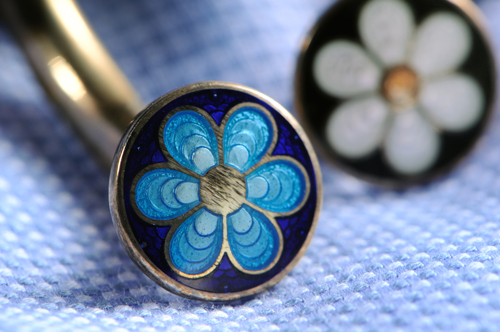For close-up photography, Nikon has a special range of lenses called Micro NIKKOR lenses. These lenses are designed to perform from infinity down to their closest focusing distances, which is usually within 20-50 cm from the subject.
Micro NIKKOR lenses can achieve magnification ratios of 1:1 (life-size) or 1:2 (half life-size) without the need for any additional accessories. The magnification ratio is the relationship between the size of the subject's projection on the imaging sensor and the subject's size in reality. If the subject projection is 20mm wide on sensor and 20mm in reality then 1:1 magnification ratio has been achieved.
The close focusing distances allow you to fill the frame with your subject and achieve true macro photography. Nikon's Micro-NIKKOR lenses are designed to perform at their best from infinity all the way down to their closest focusing distances.
 |  |
Light loss with Microphotography
Microlenses extend away from the camera at closer focusing distances, due to this design some light falls outside the sensor area and is lost thus reducing the overall exposure. Increasing the lighting will give you more control over the exposure so you can set an aperture that gives the required depth of field.
The table below shows how focusing at closer distances reduces the effective aperture for different lenses.
- With fixed focal length Microlenses the effective aperture becomes smaller at closer distances, this loss of light needs to be compensated using exposure or lighting.
- With Zoom-Micro lenses the aperture remains constant from infinity up to the maximum reproduction ratio.
| |
NIKKOR Z MC 50mm f/2.8
|
NIKKOR Z MC 105mm f/2.8 VR S
|
AF-S Micro-NIKKOR 60mm f/2.8G ED
|
AF-S VR Micro-NIKKOR 105mm f/2.8G IF-ED
|
AF Micro 60mm f/2.8D
|
AF Micro 105mm f/2.8D
|
AF Micro ED 200mm f/4D ED
|
AF Zoom-Micro ED 70-180mm f/4.5-5.6D ED
|
|
70mm
|
85mm
|
105mm
|
135mm
|
180mm
|
|
Infinity
|
f/2.8
|
f/2.8
|
f/2.8
|
f/2.8
|
f/2.8
|
f/2.8
|
f/4.0
|
f/4.5
|
f/4.5
|
f/5.0
|
f/5.3
|
f/5.6
|
|
x1:4
|
f/3.2
|
f/3.8
|
f/3
|
f/3.2
|
f/3.2
|
f/3.3
|
f/4.2
|
f/4.5
|
f/4.5
|
f/5.0
|
f/5.3
|
f/5.6
|
|
x1:3.2
|
f/3.3
|
f/4.2
|
f/3.2
|
f/3.2
|
f/3.5
|
f/3.5
|
f/4.5
|
f/4.5
|
f/4.5
|
f/5.0
|
f/5.3
|
f/5.6
|
|
x1:2
|
f/3.5
|
f/4.5
|
f/3.3
|
f/3.3
|
f/4.0
|
f/3.8
|
f/4.8
|
-
|
-
|
-
|
f/5.3
|
f/5.6
|
|
x1:1.32
|
f/4.2
|
f/5
|
f/4
|
f/4.2
|
f/4.5
|
f/4.2
|
f/5.0
|
-
|
-
|
-
|
-
|
-
|
|
x1:1
|
f/4.5
|
f/5.6
|
f/4.8
|
f/4.8
|
f/5.0
|
f/5.0
|
f/5.3
|
-
|
-
|
-
|
-
|
-
|
Camera aperture reading when using a fixed focal length Micro NIKKOR lens
The f-number displayed on the camera control panel is set by a through the lens meter reading taking into account any light loss. For this reason, the camera will display a smaller f-number than the aperture ring at close focusing distance.

Table of Micro NIKKOR lenses and the closest focus distance
A close distance between the lens and the subject can be a limitation with microphotography which results in the lens blocking the available light or being intrusive to the subject in the case of insects and wildlife. This close focusing distance is not such an important issue for static subjects such as coins and stamps. Considering the distance to the subject with a specific lens is a useful consideration with microphotography and can help you when selecting a microlens.
|
Lens
|
Reproduction Ratio
|
Closest Focus
|
|
NIKKOR Z MC 50mm f/2.8
|
1:1
|
16 cm
|
|
NIKKOR Z MC 105mm f/2.8 VR S
|
1:1
|
29 cm
|
|
AF-S DX Micro-NIKKOR 40mm f/2.8G
|
1:1
|
16 cm
|
|
AF Micro-NIKKOR 60mm f/2.8D
|
1:1
|
22 cm
|
|
AF-S Micro-NIKKOR 60mm f/2.8G ED
|
1:1
|
18 cm
|
|
AF-S DX Micro-NIKKOR 85mm f/3.5G ED VR
|
1:1
|
27 cm
|
|
AF-S VR Micro-NIKKOR 105mm f/2.8G IF-ED
|
1:1
|
30 cm
|
|
AF Micro-NIKKOR 200mm f/4D IF-ED
|
1:1
|
49 cm
|
|
PC-E Micro-NIKKOR 45mm f/2.8D ED
|
1:2
|
25cm
|
|
PC-E Micro-NIKKOR 85mm f/2.8D
|
1:2
|
39 cm
|
|
Micro-NIKKOR 55mm f/2.8
|
1:2
|
27cm
|
|
Micro-NIKKOR 105mm f/2.8
|
1:2
|
41 cm
|